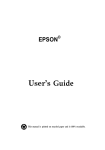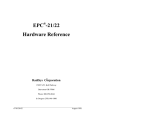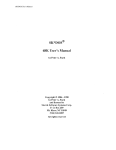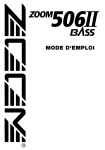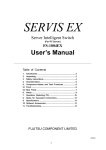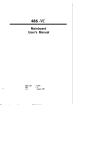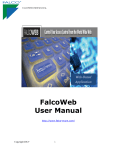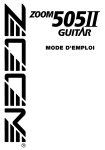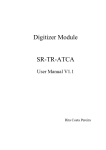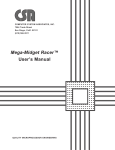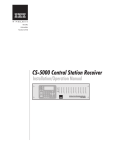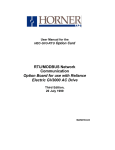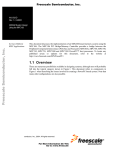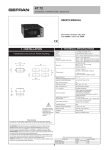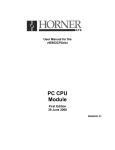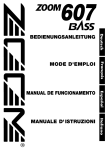Download PC/II+ & PC/II+i Technical Manual
Transcript
The megatel PC/II+ & PC/II+i Technical Manual 386SL & 486SL Based Single-Board Computers megatel computer (1986) corporation Copyright© 1 July 1999 Release 1.00 Order Number: MA990734-1.00e megatel computer (1986) corporation 125 Wendell Avenue Weston, Ontario Canada M9N 3K9 ©1999 megatel computer corporation PC/II+ & PC/II+i Technical Manual Tel: (416) 245-2953 Fax: (416) 245-6505 MA990734-1.00e Page 1 Limited Warranty All products (including software) sold are under a LIMITED WARRANTY on a return-to-factory basis against defects in workmanship and materials for a period of one year from the date of shipment. This LIMITED WARRANTY is contingent upon the proper use of the product. The WARRANTY is void if repairs are necessary due to accident, unusual physical, electrical, or electro-magnetic stress, misuse, shipping, or causes other than ordinary use. The WARRANTY will also not apply if the product has been modified by the BUYER, or if the product has been disassembled by the BUYER. Disassembly includes the removal of the serial number label on the Product without prior written permission from megatel. Any repairs attempted by the customer will void the WARRANTY. Any tips suggested in the manual or other documentation which involve physical changes to the board or a reconfiguration of the software will, if attempted, void the WARRANTY. Copyright Notice and Trademark acknowledgements. No part of this document may be copied or reproduced in any form or by any means without prior written permission from megatel computer (1986) corporation. Entire contents copyright© megatel computer (1986) corporation, Toronto, Ontario, Canada, 1993. Printed in Canada. Disclaimer megatel makes no representations or warranties with respect to any circuitry not embodied within a megatel product. megatel specifically disclaims any implied warranties of merchantability for any particular purpose of any megatel product. This manual is for information purposes only. megatel will not be liable for any direct, indirect, special, incidental, or consequential damages resulting from any information obtained from this manual. megatel does not recommend the use of its products in life support applications wherein in failure or malfunction of the component may directly threaten life or injury. As part of the terms and conditions of sale, the user of megatel products in life support applications assumes all risks of such use and indemnifies megatel against all damages. megatel assumes no responsibilty for errors which might appear in this document, and reserves the right to revise this document without notice. Service Information Should a megatel product require service, please contact the megatel Service Department between the hours of 9:00am to 5:00pm EST at TEL. (416)245-2953, or send us a fax at FAX (416)-245-6505. “megatel” is a registered trademark of megatel computer (1986) corporation “Intel” is trademarks of Intel Corporation. “Molex” is a registered trademark of Molex, Inc. "V-40H" is a trademark of NEC Corporation “IBM” is a trademark of International Business Machine Corporation & PC, XT® is a registered trademark of IBM “Apple Macintosh” is a registered trademark of Apple Inc. “Trantor” is a registered trademark of Trantor Systems, Ltd. MA990734-1.00e PC/II+ & PC/II+i Technical Manual Page 2 ©1999 megatel computer corporation MA990734-1.00e ** WARNING ** MAKE SURE: The CORRECT VOLTAGE IS APPLIED to the PC/II+ and PC/II+i • The voltages required to operate the PC/II+ & PC/II+i are +5V and GND. • Using a QTB/II*, QTB/104* or QTB/104AT* +5V & GND are connected to the PC/II+ & PC/II+i via the 96-pin Peripheral Connector and/or the 64-pin ISA Bus Connector. • One power connector found on the QTB/II, QTB/104 and QTB/104AT is that of a 4-pin male 3.5" floppy-disk styled power connector (QTB/II uses a straight up type connector, whereas the QTB/104 and QTB/104AT use the right angle versions). Molex Part #53133 for the right angle version, with the mating or "housing" connector Part #5507. • The total current drawn from the 3.5" floppy-disk styled power connector can exceed 100mA (3A max). • The QTB/104 and the QTB/104AT have an additional 8-pin (2x4) right angle male header power connector for PC/104 power connection compatibility. 4 3 2 1 Male Right Angle 1 +5V 3 GND 3.5" Floppy-styled 2 GND 4 +12V Power Connector Male Right Angle PC/104 compatible Power Connector 2 8 1 7 1 2 3 4 GND +5V KEY +12V 5 6 7 8 -5V -12V GND +5V The PC/II+ and PC/II+i is the FIRST ITEM TURNED ON & the LAST ITEM TURNED OFF • NEVER turn off the PC/II+ or PC/II+i when there are other peripherals connected and powered on, such as a printer. • This is especially important, as the bus and the printer ports are NOT buffered†. The unbuffered bus and printer port was done to reduce the power requirement of the board. • Below is an example of a buffering/filtering circuit which can be used for a single printer port line. +5V R1 D2 R2 From Printer Port Line To Printer Port D1 Ground D1: 1N4148 Signal Diode D2: +5V TransZorb (Transient Voltage Suppressor) R1 & R2: 27Ω Resistors *Note: For more detailed information on the QTB/II, QTB/104 and QTB/104AT, please see your "QTB Manual". †Note: The ISA Bus Clock is normally buffered ©1999 megatel computer corporation MA990734-1.00e PC/II+ & PC/II+i Technical Manual Page 3 Table Of Contents PC/II+ & PC/II+i Technical Manual Page Limited Warranty .......................................................................... 2 Disclaimer .................................................................................... 2 Service Information ...................................................................... 2 ** WARNING ** ........................................................................ 3 1.00 PC/II+ & PC/II+i Introductions .................................. 7 1.10 1.11 1.12 1.13 1.20 1.30 1.31 1.32 1.40 1.50 1.60 1.61 1.62 1.63 1.70 1.71 1.72 1.80 1.81 1.82 Introduction to the PC/II+ ....................................................... 7 PC/II+ General Specifications ................................................. 7 Introduction to the PC/II+i ...................................................... 8 PC/II+i General Specifications ................................................ 8 General System Notes ............................................................ 9 Power Supply ........................................................................... 9 Reset ......................................................................................... 9 Bus Drive Current .................................................................... 9 Bus Termination Option ........................................................... 9 Main Memory ........................................................................ 10 BIOS/Option ROM/User Memory ......................................... 10 On-board EPROM Enable/Disable Jumper (J5) .................... 10 Interrupts and DMA ............................................................. 11 Interval Timer ....................................................................... 12 Real-Time Clock ................................................................... 13 Real-Time Clock General Information ................................... 13 Real Time Clock Interrupt 1AH ............................................. 14 Real Time Clock Memory Map .............................................. 15 64-pin 8-bit ISA Bus Interface (J2) ..................................... 16 64-pin 8-bit Bus Header Pinout (J2) ....................................... 17 64-pin 8-bit Bus Pinout (J2) ................................................... 18 16-bit Bus Expansion Interface (J3) ................................... 25 16-bit Bus Header Pinout (J3) ................................................ 26 10-pin 16-bit Bus Expansion Pinout (J3) ............................... 26 2.00 96-Pin Peripheral I/O Connector (J1) ........................ 28 2.10 2.11 2.12 2.13 2.14 Video Interface ...................................................................... 29 LCD Control ........................................................................... 29 LCD Driver Files .................................................................... 30 Some Compatible LCD Signal Names ................................... 31 LCD Portion of RTC Memory Map ....................................... 31 continued on next page PC/II+ & PC/II+i Technical Manual Page 4 ©1999 megatel computer corporation MA990734-1.00e Table Of Contents PC/II+ & PC/II+i Technical Manual 2.15 2.20 2.21 2.30 2.31 2.40 2.41 2.50 2.51 2.52 2.53 2.54 2.60 2.61 2.62 2.63 2.64 2.70 2.71 2.72 Page 96-pin Eurocard Connector: Video Section ............................ 32 Using VGA 65530 Video Controller with VGA Monitor ...... 32 Using VGA 65530 Video Controller with EGA Monitor ....... 32 Using VGA 65530 Video Controller with STN LCD's .......... 32 Chart 1: Common Interfaces (pin assignments) and Settings 33 Parallel Printer Port ............................................................. 34 96-pin Eurocard Connector: Printer Section .......................... 35 Floppy Disk Interface ........................................................... 36 96-pin Eurocard Connector: Floppy Disk Section ................. 37 SCSI Interface ....................................................................... 38 96-pin Eurocard Connector: SCSI Section ............................. 39 Serial Communications Ports .............................................. 40 Com1: Primary Communications Port ................................... 40 Com2: Secondary Communications Port ............................... 40 96-pin Eurocard Connector: Com1 RS-232 Section .............. 41 96-pin Eurocard Connector: Com2 RS-232 Section .............. 42 Auxiliary I/O ......................................................................... 43 96-pin Eurocard Connector: Speaker Section ........................ 43 96-pin Eurocard Connector: Reset Section ............................ 43 96-pin Eurocard Connector: Keyboard Section ..................... 43 Com4 ....................................................................................... 44 Other I/O Pinouts & Descriptions ....................................... 45 96-pin Eurocard Connector: Reserved Pins ........................... 45 96-pin Eurocard Connector: Power Supply Section .............. 45 3.00 ISA High Integration Ethernet Controller ................ 46 3.10 Ethernet 10-pin Header ........................................................... 47 4.00 Flashd ............................................................................. 48 Non-Volatile On-board Solid State Disk ................................ 48 5.00 I/O Addresses ............................................................... 49 Standard I/O Map .................................................................... 49 6.00 Parts Lists & Parts Layouts ........................................ 50 6.10 6.11 6.20 6.21 PC/II+ Parts List ..................................................................... 50 PC/II+ Parts Layout ................................................................ 51 PC/II+i Parts List .................................................................... 52 PC/II+i Parts Layout ............................................................... 53 7.00 8.00 9.00 PC/II+ & PC/II+i Mechanical Specifications ............ 54 References ..................................................................... 56 megatel Service Procedure ......................................... 57 megatel SERVICE FORM ................................................. 58 ©1999 megatel computer corporation MA990734-1.00e PC/II+ & PC/II+i Technical Manual Page 5 Notes PC/II+ & PC/II+i Technical Manual Page 6 ©1999 megatel computer corporation MA990734-1.00e 1.00 PC/II+ & PC/II+i Introductions 1.10 Introduction to the PC/II+ The PC/II+ is a surface mounted single-board computer based on the Intel386™SL microprocessor and the Intel® 82360SL I/O Subsystem. It features up to 10MBytes of on-board user DRAM; up to 256KByte BIOS ROM; on-board 2MByte Solid State Disk; a graphics display controller supporting color LCD panels and analog VGA/SVGA monitors; a floppy disk controller; two full IBM compatible RS-232 serial communication ports; a partial RS-232 Serial port (used via BIOS calls); an Ethernet Local Area Network (802.3 compliant AUI & TPE [10BASE-T] signal interfaces); one parallel printer port; a serial keyboard port; a real time clock-calandar with battery back-up; and an 8-bit ISA or 16-bit Bus interface. 1.11 PC/II+ General Specifications CPU & MEMORY: •Intel386™SL Microprocessor •25MHz CPU clock frequency •Static Intel386 CPU core •AT compatible BIOS and Architecture •Up to 256KByte BIOS ROM •Up to 10MByte User DRAM INPUT/OUTPUT: •On-board 8-bit ISA or 16-bit Bus Expansion •Standard IBM XT Keyboard port •IBM compatible bi-directional Parallel Port •2 IBM compatible RS-232 Serial ports •1 RS-232 Serial subsystem (Txdata, Rxdata, & BIOS Interface) •AT Real-time clock (& Battery Back-up) VGA VIDEO CONTROLLER: •Supports Analog VGA/SVGA Monitors FLOPPY DISK CONTROLLER: and LCD, EL & Gas Plasma displays •CMOS Floppy Disk Controller •Up to 512KB Video DRAM •Can drive 360KByte, 720KByte, 1.2MByte, •Enhanced backward compatibility or 1.44MByte capacity drives with EGA™, CGA™, Hercules™ •Can support up to two drives & MDA™ standards •Will boot standard versions of PC, •Supports Color flat panels (ie. TFT & STN) MS DOS®, and DR DOS •Supports panels from popular manufacturers such as Sharp, NETWORK: Densitron and Seiko/Epson •On-board Ethernet LAN •VGA Register Set Compatible (Local Area Network) •802.3 compliant AUI and TPE (10BASE-T) SCSI CONTROLLER: serial interfaces •ASPI compatible SCSI controller •Automatic switching between AUI and •Standard IBM PC AT Hard Disk BIOS TPE ports support via SCSI port •64KBytes local DRAM •Complete interface for SCSI •16-bit I/O accesses local DRAM with compatible hard drives zero added wait states •Multi-media software supports CD ROMs, audio devices and optical MISCELLANEOUS: storage •Only 100mmx100mm (4"x4") •Requires only +5V operation SOLID STATE DISK: •Power consumption less than 5 Watts •On-board 2MByte solid state disk (typical) •megatel drivers for reading & writing ©1999 megatel computer corporation MA990734-1.00e PC/II+ & PC/II+i Technical Manual Page 7 1.12 Introduction to the PC/II+i The PC/II+i is a surface mounted single-board computer based on the Intel486SL™ microprocessor and the Intel® 82360SL I/O Subsystem. It features up to 16MBytes of on-board user DRAM (protected mode); up to 256KByte BIOS in Flash™ EPROM; on-board 2MByte Solid State Disk; a graphics display controller supporting color LCD panels and analog VGA/ SVGA monitors; a floppy disk controller; two full IBM compatible RS232 serial communication ports; a partial RS-232 Serial port (used via BIOS calls); an Ethernet Local Area Network (802.3 compliant AUI & TPE [10BASE-T] signal interfaces); one parallel printer port; a serial keyboard port; a real time clock-calandar with battery back-up; and an 8-bit ISA or 16-bit Bus interface. 1.13 PC/II+i General Specifications CPU & MEMORY: •Intel486™SL Microprocessor •25MHz or 33MHz CPU clock frequency •Built-in 8K Cache; floating point unit •Full 32-bit DRAM Data Bus •486DX compatibility & performance •AT compatible BIOS and Architecture •Up to 256KByte BIOS in Flash™ EPROM •4MByte or 16MByte User DRAM •PC/104 Bus Compatible option with Adapter •ISA Bus Compatible option with Adapter INPUT/OUTPUT: •On-board 8-bit ISA or 16-bit Bus Expansion •Standard IBM PC Keyboard port •8-bit general purpose Parallel Port •2 IBM compatible RS-232C Serial ports •1 BIOS compatible RS-232C serial port (Txdata, Rxdata, to a BIOS interface) •Independent software selectable BAUD rates •Voltage converter for serial +/- voltages •AT Real-time clock with Battery Back-up •M-Systems Flash File System SOLID STATE DISK: FLOPPY DISK CONTROLLER: •On-board 2MByte solid state disk (typical) •CMOS Floppy Disk Controller •Can drive 360KByte, 720KByte, 1.2MByte, •megatel drivers for reading & writing or 1.44MByte capacity drives VGA VIDEO CONTROLLER: •Can support up to two drives •Supports Analog VGA/SVGA Monitors •Will boot standard versions of PC, and LCD, EL & Gas Plasma displays MS DOS®, and DR DOS •Up to 512KB Video DRAM •Enhanced backward compatibility NETWORK: with EGA™, CGA™, Hercules™ •On-board Ethernet LAN (Local Area Network) & MDA™ standards •802.3 compliant AUI and TPE (10BASE-T) •Supports Color flat panels (ie. TFT & STN) serial interfaces •Supports panels from popular •Automatic switching between AUI and manufacturers such as Sharp & Seiko TPE ports •64KBytes local DRAM SCSI CONTROLLER: •16-bit I/O accesses local DRAM with •5380 compatible SCSI controller zero added wait states •ASPI compatible software drivers included •Standard IBM PC AT Hard Disk BIOS MISCELLANEOUS: support via SCSI port (INT13h) •Only 100mmx100mm (4"x4") •Complete interface for SCSI •Requires only +5V operation compatible hard drives •Power consumption of 6 Watts (typical for •Multi-media software supports CD ROMs, 33MHz board with 4MBytes DRAM) audio devices and optical storage •MTBF: Not less than 200,000 hours PC/II+ & PC/II+i Technical Manual Page 8 ©1999 megatel computer corporation MA990734-1.00e 1.20 General System Notes Power Supply The PC/II+ & PC/II+i use +5V ±5%. The voltage Rise time should be from +2V to +5V within 10ms. Reset The /Reset line found at J1 pin 31A (96-pin eurocard connector) should be driven by an open-collector or mechanical switch. Bus Drive Current All Bus signals except for the /BS16 signal can be driven with devices capable of providing 4mA sink current. /BS16 signal can be driven with devices capable of providing 10mA sink current. Note: The /BS16 signal is equivalent to the /IOCS16 and /MEMCS16 signal. Bus Termination Option AC Bus termination provides termination close to the characteristic impedance of the signal lines without exceeding the DC output current capabilities of the drivers. This increases data integrity and system reliability. A resistor-capacitor network of 40-60 ohms in series with 30-70pF can be connected between each bus signal and ground. ©1999 megatel computer corporation MA990734-1.00e PC/II+ & PC/II+i Technical Manual Page 9 1.30 Main Memory The standard PC/II+ utilizes a total of 2MByte, 4MByte, 8MByte or 10MBytes of user DRAM. In the 4MByte system, page-interleaving is utilized. The PC/II+i utilizes 4MBytes or 16MBytes of user DRAM. The average/effective wait states in H.S. Fast Page Mode is 0.2 wait states. The BIOS automatically checks the memory at Power-On to determine the amount of RAM available. No straps or jumpers are needed to specify the size of the Main Memory. 1.31 BIOS/Option ROM/User Memory The standard ROM installed on the PC/II+ or PC/II+i is a 2Mbit (256KByte) E28F020 Flash EPROM which contains the BIOS (including the VGA BIOS and SCSI Option ROM) for the system. There is 128kBytes of user Option Module space/Bus space located from address C0000h to DFFFFh. 1.32 On-board EPROM Enable/Disable Jumper (J5) Since the PC/II+ or PC/II+i on-board Flash BIOS EPROM is soldered onto the board, a 2-pin jumper has been installed to allow an external EPROM, which contains our BIOS, to be used via the bus. To disable the on-board Flash BIOS EPROM remove the shorting plug, from the 2-pin jumper, that is located at the edge of the board that sides the 196-pin 386SL and the 44-pin 82595 Ethernet controller. By removing the shorting plug, the on-board BIOS EPROM is disabled. This jumper is used strictly by megatel and must be installed in order for the PC/II+ or PC/II+i to function properly. Do not remove. 386SL J5 1 1 82595 PC/II+ & PC/II+i Technical Manual Page 10 To Use On-board BIOS EPROM: Leave shorting plug on. ©1999 megatel computer corporation MA990734-1.00e 1.40 Interrupts and DMA The PC/II+ & PC/II+i utilizes the Intel® 82360SL to provide 8259 compatible interrupt request lines and 8237 compatible DMA channels. Within the 82360SL, two interrupt controllers are used to provide interrupt request lines and two DMA controllers are used to provide DMA request lines. One interrupt line (IRQ2) is used to cascade the two interrupt controllers together leaving a total of 14 interrupt request lines. One DMA channel (DRQ4) is used to cascade the two DMA controllers together leaving a total of 7 DMA channels. The interrupt request lines and DMA channels are shown in the tables below. Interrupt (IRQ) (Controller 1) (Controller 2) 0 1 2 9 3 4 5 6 7 8 10 11 12 13 14 15 DMA (DRQ) (Controller 1) (Controller 2) 0 1 2 3 4 5 6, 7 Description Available On Bus Timer Keyboard VGA Controller (NOTE: In ISA systems, IRQ2=IRQ9) Serial Port (Com2) Serial Port (Com1) Unused Floppy Disk Controller Printer RTC Timer/Alarm Unused Ethernet Mouse Reserved (Numeric Co-Processor) Reserved (IDE Hard Drive) SCSI Controller Description SCSI Controller Unused Floppy Disk Unused Cascades to Controller 1 via DMA Channel 4 Reserved Unused (DRQ6 tied to DRQ7; /DACK7 tied to /MASTER) Yes Yes Yes Yes Yes Yes Yes Yes* Available On Bus Yes Yes Yes Yes* *Note: Inputs Interrupt 14 & DRQ6 & DRQ7 are hardwired together as DRQ16. Outputs /DACK6 & /DACK7 are logically ANDED to generate /DACK16. Overall Note: Since devices tied to Interrupt lines normally Tri-State their outputs, Interrupts may be shared if the interrupt handler is written to determine which device actually generated an interrupt. ©1999 megatel computer corporation MA990734-1.00e PC/II+ & PC/II+i Technical Manual Page 11 1.50 Interval Timer The PC/II+ & PC/II+i utilize the Intel® 82360SL to provide 8254 compatible Programmable Timer Counters. Timer 0, Timer 1 & Timer 2 are clocked by a 1.193MHz clock, resulting in a minimum timing resolution of 838ns. The Gate inputs for Timer 0 and Timer 1 are tied high. The Gate inputs for Timer 2 are controlled by the Timer 2 Gate Bit, which is Bit 0 of Port 061h. The output from Timer 0 is connected to interrupt input IRQ0 on the Interrupt Controller. This timer is used by the operating system for its internal real-time clock. The output from Timer 1 is used to generate a CPU Hold Request when it is time for a refresh cycle. Timer 2 is used to generate signals for the Speaker output. The Timer 2 output is gated with the SPEAKER DATA bit (bit 1 of Port 061h) to drive the SPKR output. The combination of the Timer 2 Gate control bit and the SPEAKER Data bit allow complex waveforms to be generated on the Speaker output. The state of the TIMER 2 output can be read at Port 061h bit 5. The Speaker output, SPKR, is pin A9 of the 96-pin eurocard connector (J1). It is intended to drive a piezo-electric audio transducer connected between the SPKR pin and ground. PC/II+ & PC/II+i Technical Manual Page 12 ©1999 megatel computer corporation MA990734-1.00e 1.60 Real-Time Clock 1.61 Real-Time Clock General Information The Real-time Clock (RTC) on the PC/II+ & PC/II+i is part of the Intel® 82360SL. The RTC section also uses a 32.768 kHz crystal and a 3.0V Lithium battery. The battery is soldered onto the circuit board. Features of the clock chip include: • 128 Bytes battery backed up CMOS RAM • Low standby current (5µA @ 3.0V) • Four Year Calendar • 24 or 12 Hour Format • Automatic word addressing incrementing • Programmable alarm, timer, and interrupt function The clock comes set at proper date and time from the factory for North American EST. The software for the clock is included as part of the BIOS with boards containing the Real-Time-Clock option. Standard features of the RTC option include both leap year and year changeover. The DOS clock is updated automatically by the RTC upon Boot Up. Should you change the time or date in DOS, the PC/II+ & PC/II+i will conversely update the RTC chip. The PC/II+ & PC/II+i uses standard DOS instructions to change the time and the date. If you are using standard DOS where the time and date is displayed upon boot up, you may change the time and date at this point. While in DOS, the time and date can also be changed by typing TIME, then entering the desired time and typing DATE, then entering the desired date. The 128 Bytes of battery backed CMOS RAM is also used to store information pertaining to the CMOS RAM SETUP & LCD Driver file values. The CMOS RAM SETUP includes such information as the time and date; the amount of useable memory available; video mode (monitor type); floppy disk drive type and whether there are one or two drives connected. (For more information regarding the CMOS RAM SETUP, please read the "Options and Defaults in the PC/II+ Series SBC CMOS RAM SETUP" section in the "PC/+v & PC/II+ Series Products User's Manual") When using an LCD panel, EL or Plasma display, a driver file must be loaded into the 65530 Video controller registers. The LCD driver file values are stored in the CMOS RAM of the Real-Time Clock and loaded into the proper 65530 registers upon boot up (For more information regarding LCD driver files, please read the "65530 LCD Manual", formerly entitled the "PC/II+ LCD Manual"). continued on next page ©1999 megatel computer corporation MA990734-1.00e PC/II+ & PC/II+i Technical Manual Page 13 The real time clock is addressed at I/O Address 0070h-0071h and drives IRQ8. The 3.0V Lithium battery is rated for 190mAh to 200mAh (typical) in an operation temperature range of -20˚C to +70˚C. The storage temperature range is -40˚C to +60˚C and the Self discharge is less than 1% per year at 25˚C. It is intended for use with the Real-Time Clock only. 1.62 Real Time Clock Interrupt 1AH The PC/II+ & PC/II+i support the Interrupt 1AH AT compatible clock functions. CLKGET & CLKPUT are two other real time clock functions that are implemented on the PC/II+ & PC/II+i, accessible through INT1AH. Function Prior To INT1AH Upon Return from INT1AH CLKGET AH=FEH AL=Value in real time clock register DL=register* DH=1DH NOTE: *register=specify real time clock register CLKPUT AH=FFH No values returned DL=register* DH=1CH AL=value** NOTE: *register=specify real time clock register **value =specify value to go into register PC/II+ & PC/II+i Technical Manual Page 14 ©1999 megatel computer corporation MA990734-1.00e 1.63 Real Time Clock Memory Map Register Address Function Decimal Hexadecimal 000 001 002 003 004 005 006 007 008 009 010-013 014 015 016 017 018 019 020 021 022 023 024 025 026 027 028-045 046 047 048 049 050 051 053-064 065 066-074 075 076 077 078-079 080-127 Note: 00h 01h 02h 03h 04h 05h 06h 07h 08h 09h 0Ah-0Dh 0Eh 0Fh 10h 11h 12h 13h 14h 15h 16h 17h 18h 19h 1Ah 1Bh 1Ch-2Dh 2Eh 2Fh 30h 31h 32h 33h 35h-40h 41h 42h-4Ah 4Bh 4Ch 4Dh 4Eh-4Fh 50h-7Fh Control/Status 100ths of a Second Seconds Minutes Hours Year/Century Month/Day Timer Reserved for Alarm Control Reserved for Alarm Registers or Ram Status Registers A, B, C, D Diagnostic Status Byte Shutdown Status Byte Floppy Drive Type Byte Reserved Fixed Drive Type Byte Reserved Equipment Byte Base Memory Size (Low Byte) Base Memory Size (High Byte) Expanded Memory Size (Low Byte) Expanded Memory Size (High Byte) Drive C - Fixed Drive Type (Extended Byte) Drive D - Fixed Drive Type (Extended Byte) Reserved Reserved Checksum (Low Byte) for registers 10h-2Dh Checksum (High Byte) for registers 10h-2Dh Expanded Memory Size (Low Byte) Expanded Memory Size (High Byte) Date Century Byte Information Flags Reserved Equipment Byte (Extended) Reserved Reserved - LCD Signature Reserved - LCD Type Byte Reserved Reserved Reserved When using the Direct Edit of the CMOS RAM SETUP, only registers 10h to 7Fh are accessible. ©1999 megatel computer corporation MA990734-1.00e PC/II+ & PC/II+i Technical Manual Page 15 1.70 64-pin 8-bit ISA Bus Interface (J2) The PC/II+ & PC/II+i Bus interface provides a quick route for adding a variety of standard I/O functions while keeping the complexity and physical size of the system to a minimum. OEM users who are designing their own special purpose I/O functions, may find it convenient to use the PC/II+ or PC/II+i Bus interface. Note: I/O cycles, with /BS16 selected as a 16-bit bus, must be qualified with /IOR and /IOW OR with the top bits (A15 to A19) addressing 00000hex. (see "16-bit Bus Expansion" chapter) The 8-bit ISA Bus connector (J2) found on the standard PC/II+ & PC/II+i is that of a 64-pin dual row header (2x32, on 0.100" [2.54mm] spacing). The last 62 pins of J2 (pins A1 to A31 and B1 to B31) correspond to the PC Bus interface. The 8-bit ISA Bus connector found on the custom PC/II+ & PC/II+i is that of a 62-pin male edge connector. * WARNING * The following signals used on the PC/II+ & PC/II+i 8-bit Bus are NOT Power pins. PC/II+ & PC/II+i J2 Pin # B5 B7 B9 PC/II+ & PC/II+i 8-bit Bus Name IRQ10 /DACK16 IRQ14 (DRQ16) Old XT or AT Signal Name -5V -12V +12V Bus Termination Option AC Bus termination provides termination close to the characteristic impedance of the signal line without exceeding the DC output current capabilities of the drivers. This increases data integrity and system reliability. A resistor-capacitor network of 40-60 ohms in series with 3070pF can be connected between each bus signal and ground. Bus Drive Current All Bus signals except for the /BS16 signal can be driven with devices capable of providing 4mA sink current. The /BS16 signal can be driven with devices capable of providing 10mA sink current. Note: The /BS16 signal is equivalent to the /IOCS16 and the /MEMCS16 signal. For Bus timing, please refer to the "References" section of this manual. PC/II+ & PC/II+i Technical Manual Page 16 ©1999 megatel computer corporation MA990734-1.00e 1.71 64-pin 8-bit Bus Header Pinout (J2) J2 Pin A0 Pin B0 * WARNING * Some of these signals (*) USED TO BE power pins DO NOT CONNECT POWER TO THESE PINS!!! PC Bus Name PC/II+(i) J2 PC/II+(i) J2 PC Bus Name GND /IOCHK D7 D6 D5 D4 D3 D2 D1 D0 IORDY AEN A19 A18 A17 A16 A15 A14 A13 A12 A11 A10 A9 A8 A7 A6 A5 A4 A3 A2 A1 A0 A0 A1 A2 A3 A4 A5 A6 A7 A8 A9 A10 A11 A12 A13 A14 A15 A16 A17 A18 A19 A20 A21 A22 A23 A24 A25 A26 A27 A28 A29 A30 A31 B0 B1 B2 B3 B4 B5 B6 B7 B8 B9 B10 B11 B12 B13 B14 B15 B16 B17 B18 B19 B20 B21 B22 B23 B24 B25 B26 B27 B28 B29 B30 B31 +5V GND RESET +5V IRQ2 IRQ10* DRQ2 /DACK16* /0WS IRQ14 (DRQ16)* GND /MEMW /MEMR /IOW /IOR /DACK3 DRQ3 /DACK1 DRQ1 REFRESH CLK IRQ7 IRQ6 IRQ5 IRQ4 IRQ3 /DACK2 TC ALE +5V OSC GND ©1999 megatel computer corporation MA990734-1.00e PC/II+ & PC/II+i Technical Manual Page 17 1.72 64-pin 8-bit Bus Pinout (J2) Symbol Pin No. Type Name and Function A0-A19 A31-A12 O CPU Address lines: These lines provide the memory and I/O address for the entire bus cycle. These lines are active high. D0-D7 A9-A2 I/O Bi-directional Data Bus: Data is input on these lines during memory, I/O, and interrupt acknowledge read cycles. Data is output on these lines during memory and I/O write cycles. These lines are active high. +AEN A11 O Address Enable: AEN is used to indicate that DMA transfers are taking place. This line is active high. When this line is active, the DMA controller has control of the address bus, the data-bus Read command lines (memory and I/O) and the data-bus Write command lines (memory and I/O). +IORDY A10 I I/O Channel Ready: I/O Channel Ready is the acknowledgement from the addressed memory or I/O device that it will complete the data transfer. This line is active high. A low input on this line will insert wait-states into the processor's bus cycle to lengthen I/ O or memory cycles so that it may complete its read or write transfer. This line should not be held low for no more than 2.5 microseconds. /IOCHK A1 I I/O Channel Check: -I/OCHK provides the CPU with parity error information regarding the memory or devices using the I/O channel. This signal is active low. When this signal is active, an interrupt is generated to the CPU. +OSC B30 O Oscillator: The OSC is a constant speed 14.31818MHz clock. This signal is not synchronous with the system clock and has a duty cycle of 50%. continued on next page PC/II+ & PC/II+i Technical Manual Page 18 ©1999 megatel computer corporation MA990734-1.00e 1.72 64-pin 8-bit Bus Pinout (J2) (continued) Symbol Pin No. Type Name and Function +ALE B28 O Address Latch Enable: This signal is used to latch valid addresses and memory decodes from the microprocessor. When used with AEN, this signal is available to the I/O channel to indicate valid microprocessor or DMA addresses. ALE is an active high signal and microprocessor addresses are latched on the falling edge (high to low) of the ALE signal. TC B27 O Terminal Count: A pulse is put on this line to indicate that the current DMA transfer has reached the terminal count. This signal is active high. /REFRESH B19 O Refresh: This signal is used to refresh dynamic ram and can be driven by a microprocessor on the I/O channel This signal is active low. In the traditional PC/XT architecture this channel is also known as -DACK0. /DACK1 /DACK3 B17 B15 O O DMA Acknowledge 1 & 3 (Spare): DACK1 & DACK3 are used to acknowledge DMA requests which notifies the individual peripheral it has been granted a DMA cycle. These lines are active low. /DACK2 B26 O DMA Acknowledge 2 (Floppy): DACK2 is used to acknowledge DMA requests which notifies the individual peripheral it has been granted a DMA cycle. This line is active low. +DRQ1 +DRQ3 B18 B16 I I DMA Request Line 1 and 3 (Spare): These lines are individual asynchronous channel request lines input used by peripheral circuits to obtain DMA service. In the traditional XT architecture DRQ1 is unused and DRQ3 is used for a fixed disk controller. These lines are active high. continued on next page ©1999 megatel computer corporation MA990734-1.00e PC/II+ & PC/II+i Technical Manual Page 19 1.72 64-pin 8-bit Bus Pinout (J2) (continued) Symbol Pin No. Type Name and Function +DRQ2 B6 I DMA Request Line 2 (Floppy): DRQ2 is an individual asynchronous channel request input used by the floppy disk controller to obtain DMA service. This line is active high. +IRQ2 (IRQ9) B4 I Interrupt Request 2 (EGA/VGA): IRQ2 is an asynchronous input used to request interrupt service. An interrupt request is executed by raising IRQ2 (low to high) and holding it high until it is acknowledged (edge triggered mode), or holding IRQ2 at a high level until it is acknowledged (level triggered mode). This line is active high. In the PC/II+ & PC/II+i architecture, this line is used by the video controller. In the traditional XT/ AT architecture this channel is used by LPT2 and some network cards. +IRQ3 B25 I Interrupt Request 3 (Com2): IRQ3 is an asynchronous input used to request interrupt service. An interrupt request is executed by raising IRQ3 (low to high) and holding it high until it is acknowledged (edge triggered mode), or holding IRQ3 at a high level until it is acknowledged (level trigger mode). This line is active high. In the PC/II+, PC/II+i and traditional XT/AT architecture, this channel is used by the Com2 port and some network cards. +IRQ4 B24 I Interrupt Request 4 (Com1): IRQ4 is asynchronous input used to request interrupt service. An interrupt request is executed by raising IRQ4 (low to high) and holding it high until it is acknowledged (edge triggered mode), or holding IRQ4 at a high level until it is acknowledged (level triggered mode). This line is active high. In the PC/II+, PC/II+i and traditional XT/AT architecture, this channel is used by the Com1 port and some network cards. continued on next page PC/II+ & PC/II+i Technical Manual Page 20 ©1999 megatel computer corporation MA990734-1.00e 1.72 64-pin 8-bit Bus Pinout (J2) (continued) Symbol Pin No. Type Name and Function +IRQ5 B23 I Interrupt Request 5 (Spare): IRQ5 is an asynchronous input used to request interrupt service. An interrupt request is executed by raising IRQ5 (low to high) and holding it high until it is acknowledged (edge triggered mode), or holding IRQ5 at a high level until it is acknowledged (level triggered mode). This line is active high. In the PC/II+, PC/II+i and traditional XT/AT architecture, this channel is used by the fixed disk controller. +IRQ6 B22 I Interrupt Request 6 (Floppy Disk): IRQ6 is an asynchronous input used to request interrupt service. An interrupt request is executed by raising IRQ6 (low to high) and holding it high until it is acknowledged (edge triggered mode), or holding IRQ6 at a high level until it is acknowledged (level triggered mode). This line is active high. In the PC/II+, PC/II+i and traditional XT/AT architecture, this channel is used by the floppy disk controller. +IRQ7 B21 I Interrupt Request 7 (Printer Port): IRQ7 is an asynchronous input used to request interrupt service. An interrupt request is executed by raising IRQ7 (low to high) and holding it high until it is acknowledged (edge triggered mode), or holding IRQ7 at a high level until it is acknowledged (level triggered mode). This line is active high. In the PC/II+, PC/II+i and traditional XT/AT architecture, this channel is used by the parallel printer port (LPT1). CLK B20 O Bus Clock: Clock is the processor clock. This clock is a square wave with a frequency of 12.5MHz or 16MHz (PC/II+i only). Note: Special orders will allow boards to be shipped with a hardware strapped clock of 1/2 the System Clock. /IOR B14 O I/O Read: IOR instructs an I/O device to place data onto the I/O channel. This signal is active low. continued on next page ©1999 megatel computer corporation MA990734-1.00e PC/II+ & PC/II+i Technical Manual Page 21 1.72 64-pin 8-bit Bus Pinout (J2) (continued) Symbol Pin No. Type Name and Function /IOW B13 O I/O Write: IOW instructs an I/O device to read data off of the I/O channel. This signal is active low. /MEMR B12 O Memory Read: MEMR instructs the memory to place data onto the I/O channel. The signal is active low. /MEMW B11 O Memory Write: MEMW instructs the memory to read data off of the I/O channel. This signal is active low. RESET B2 O Reset Drive: Reset Drv indicates that a reset conditon is in progress. This signal is active high and is synchronized to the falling edge of CLK. B0, B3 B29 I VCC: Externally supplied +5V +5V GND A0, B1 I/O B10, B31 GND: Power return of power supply WARNING The following pin assignments are NO LONGER USED AS POWER PINS DO NOT APPLY POWER TO THESE PINS!!!! IRQ14 B9 I B9 I (No longer +12V) /DRQ16 Interrupt Request 14 (Spare): IRQ14 is an asynchronous input used to request interrupt service. An interrupt request is executed by raising IRQ14 (low to high) and holding it high until it is acknowledged (edge triggered mode), or holding IRQ14 at a high level until it is acknowledged (level triggered mode). This line is active high. In the traditional AT architecture, this channel is used by the IDE fixed disk. DMA Request Line 16: IRQ14, DRQ6 & DRQ7 are hardwired together as DRQ16. continued on next page PC/II+ & PC/II+i Technical Manual Page 22 ©1999 megatel computer corporation MA990734-1.00e 1.72 64-pin 8-bit Bus Pinout (J2) (continued) WARNING Some of the following pin assignments are NO LONGER USED AS POWER PINS DO NOT APPLY POWER TO THESE PINS!!!! Symbol /0WS Pin No. Type Name and Function B8 O Zero Wait States: In the traditional XT architecture, this pin was used for /Card Select. In the PC/II+, PC/II+i and traditional AT architecture, this pin is used for 0WS (zero wait states). This pin is active low. B7 O DMA Acknowledge 16 (Spare): DACK16 is used to acknowledge DMA requests which notifies the individual peripheral it has been granted a DMA cycle. These lines are active low. In the traditional XT and AT this pin was used for -12V or unused. /DACK6 & /DACK7 are logically ANDED together to generate /DACK16. B5 I Interrupt Request 10 (Spare): IRQ10 is an asynchronous input used to request interrupt service. An interrupt request is executed by raising IRQ10 (low to high) and holding it high until it is acknowledged (edge triggered mode), or holding IRQ10 at a high level until it is acknowledged (level triggered mode). This line is active high. In the traditional XT architecture, this channel is used for -5V. In the traditional AT architecture, this channel is unused. (No Longer /Card Select) /DACK16 (No Longer -12V) IRQ10 (No Longer -5V) ©1999 megatel computer corporation MA990734-1.00e PC/II+ & PC/II+i Technical Manual Page 23 Notes PC/II+ & PC/II+i Technical Manual Page 24 ©1999 megatel computer corporation MA990734-1.00e 1.80 16-bit Bus Expansion Interface (J3) The PC/II+ & PC/II+i also provide an expansion to a 16-bit Data Bus interface, in the form of the additional 10-pin single row header strip (J3) (1x10, on 0.100" [2.54mm] spacing). Note: I/O cycles, with /BS16 selected as a 16-bit bus, must be qualified with /IOR and /IOW OR with the top bits (A15 to A19) addressing 00000hex. Bus Termination Option AC Bus termination provides termination close to the characteristic impedance of the signal line without exceeding the DC output current capabilities of the drivers. This increases data integrity and system reliability. A resistor-capacitor network of 40-60 ohms in series with 3070pF can be connected between each bus signal and ground. Bus Drive Current All Bus signals except for the /BS16 signal can be driven with devices capable of providing 4mA sink current. The /BS16 signal can be driven with devices capable of providing 10mA sink current. Note: The /BS16 signal is equivalent to the /IOCS16 and /MEMCS16 signal. For Bus timing, please refer to the "References" section of this manual. ©1999 megatel computer corporation MA990734-1.00e PC/II+ & PC/II+i Technical Manual Page 25 1.81 16-bit Bus Header Pinout (J3) J3 PC Bus Name /BS16 D15 D14 D13 D12 D11 D10 D9 D8 /SBHE 1.82 PC/II+ & PC/II+i (J3) Pin No. 1 2 3 4 5 6 7 8 9 10 10-pin 16-bit Bus Expansion Pinout (J3) Symbol /BS16 Pin 1 Pin No. Type Name and Function 1 I Bus Select 16: This signal indicates that an ISA bus peripheral wishes to execute a 16-bit I/O cycle. This signal has an active pull-up, so when not driven, the default I/O bus cycle is 8 bits. This signal is active low. D15 to D8 2, 3, 4, 5, I/O 6, 7, 8, 9 Bi-directional Data Bus: Data is input on these lines during memory, I/O, and interrupt acknowledge read cycles. Data is output on these lines during memory and I/O write cycles. These lines are active high. /SHBE System Byte High Enable: This signal indicates that data is being transferred on the upper byte of the 16-bit data bus (D8 to D15). This signal is active low. 10 O PC/II+ & PC/II+i Technical Manual Page 26 ©1999 megatel computer corporation MA990734-1.00e Notes ©1999 megatel computer corporation MA990734-1.00e PC/II+ & PC/II+i Technical Manual Page 27 2.00 96-Pin Peripheral I/O Connector (J1) 32 1 Right Angle 96-pin DIN (Eurocard Connector) C B A C B A 32 1 Straight Up 96-pin Header PIN 1 2 3 4 5 6 7 8 9 10 11 12 13 14 15 16 17 18 19 20 21 22 23 24 25 26 27 28 29 30 31 32 A VID-P3 (SB or VID) VID-P5 (SR) VID-P8* VID-SCK VID-M† VID-P10 (ANBLUE) VID-P11 (ANRED) RESERVED SPEAKER PRN-SLCT PRN-PE PRN-BUSY PRN-AKN PRN-D7 PRN-D6 PRN-D5 PRN-D4 PRN-D3 PRN-D2 PRN-D1 PRN-D0 PRN-STRB SCSI-D0 SCSI-D1 SCSI-D2 SCSI-D3 SCSI-D4 SCSI-D5 SCSI-D6 SCSI-D7 SCSI-DP /RESET ROWS B VCC VID-P0 (BLUE) VID-P1 (GREEN) VID-P2 (RED) VID-GND VID-P6 (LD0) COM2-RI COM2-DTR COM2-CTS COM2-TXD COM2-RTS COM2-RXD COM2-DSR COM2-DCD COM4-RX COM4-TX KBD-DATA KBD-CLK PRN-SELECTIN PRN-INIT PRN-ERR PRN-AUTO SCSI-ATN SCSI-BSY SCSI-AKN SCSI-RST SCSI-MSG SCSI-SEL SCSI-C/D SCSI-REQ SCSI-I/O VCC Component (Top) View C GND VID-FRM (VSYNC) VID-LC (HSYNC) VID-P9 (ANGREEN) VID-P4 (INT or SG) VID-P7 (LD1) COM1-RI COM1-DTR COM1-CTS COM1-TXD COM1-RTS COM1-RXD COM1-DSR COM1-DCD FDD-DCHG FDD-HS FDD-RDD FDD-WP FDD-TRK0 FDD-WE FDD-WD FDD-STP FDD-DIRC FDD-MD2 FDD-DS1 FDD-DS2 FDD-MD1 FDD-IDX FDD-GND RESERVED FDD-RPM GND *Note: J1A pin 3 can be connected to P8 instead of being connected to /ENAVEE. †Note: J1A pin 5 can be connected to /BLANK instead of being connected to the M signal. PC/II+ & PC/II+i Technical Manual Page 28 ©1999 megatel computer corporation MA990734-1.00e 2.10 Video Interface The Video Interface on the PC/II+ & PC/II+i utilizes the Chips® 65530 Video Controller. This interface is compatible with the IBM-PS/2 Video Graphics Array (VGA). The VGA Controller I/O Address is 03B0h-03DFh and utilizes IRQ2 (IRQ9). The Video Interface includes a separate 512KByte* of Read/Write memory called the "Display Buffer or Character generator video RAM", in which the data to be displayed is stored. The Display Buffer is normally mapped into the CPU's address space at 0A0000h to 0BFFFFh. *Note: Configurations using 256KByte or 1MByte, instead of the standard 512KByte, is available. The display controller incorporates high speed Local Bus Interface for improved performance. Optionally, the display memory may be linearly mapped in the private local bus memory space above the normal ISA 16MByte boundry. 2.11 LCD Control megatel's PC/II+ & PC/II+i are unique in that they provide direct full panel LCD control as an integral part of the on-board video functions. Some of the features, which are part of the Chips® 65530 video controller chip, are as follows: • IBM VGA and Register level compatibility. • Enhanced backward compatibility to EGA™, CGA™, Hercules™, and MDA™ standards • Interlaced and non-interlaced CRT Displays with resolutions of up to 1024x768 with 16 colors (a resolution of 800x600 with up to 256 colors) can be connected to the PC/II+ & PC/II+i. • LCD, EL and Plasma panels with resolutions of: 640x200, 640x400, 640x480, 800x600, 1024x768, 1280x1024 can be connected to the PC/II+ & PC/II+i. • Up to 64-level gray levels on monochrome LCD, EL and gas plasma panels • Up to 185,193 colors on color TFT LCD, EL and gas plasma panels and up to 226,981 colors on color STN LCD panels. • A single-screen panel or dual-screen panel (panels that are split into top and bottom halves) can be driven. • Data can be sent to the panel in parallel 4 bits or 8 bits at a time or in series. 16-bit data can be sent when using the megatel Video Paddle Board* • Vertical and Horizontal Compensation of displayed text or graphics images on a flat panel. • SMARTMAP™ intelligent color to gray scale conversion • Programmable polynomial based Frame Rate Control grey scale algorithm supports fast response "mouse quick" displays by reducing flicker without increasing panel vertical refresh rate. • Integrated RAMDAC *Note: For more information on the Video Paddle Board, please see the "PC/+v & PC/II+ Series Products User's Manual" ©1999 megatel computer corporation MA990734-1.00e PC/II+ & PC/II+i Technical Manual Page 29 2.12 LCD Driver Files An LCD, EL or Gas Plasma display is, to the PC/II+ & PC/II+i CMOS RAM SETUP, considered a "Special" Display Type. To use one of these displays, a software driver must be used to initialize (or set) the Chips® 65530 video controller registers to the values which correspond to the display being used. The PC/II+ & PC/II+i BIOS contains Generic LCD Software Drivers, in the form of a Table, that allow many of the popular LCD, EL and Gas Plasma displays to be used. An "LCD Driver File List", which contains our current list of Hex Settings, Panel Manufacturers and Pinouts* can be found in the "65530 LCD Manual", formerly entitled the "PC/II+ LCD Manual". *WARNING: It is the user's responsibility to check for correctness in pinout. To implement one of the LCD Software Drivers, one must use the CMOS RAM SETUP. One of the fields in the CMOS RAM SETUP is the "Display Type". This should be set to "Special" when using an LCD, EL or Gas Plasma Display. A new field should appear beside the selected "Special" setting. Scroll through this field until you have reached the desired twodigit Hex Setting†. †Note: Be sure to save these settings when exiting the CMOS RAM SETUP. Intelligent dot matrix LCD panels do not require the same type of software drivers as do the LCD, EL and Gas Plasma displays. These types of panels are used via the printer port and with an ASCII software program, can output your message etc... . Note: For more information regarding the CMOS RAM SETUP, please see "Real-Time Clock" chapter. PC/II+ & PC/II+i Technical Manual Page 30 ©1999 megatel computer corporation MA990734-1.00e 2.13 Some Compatible LCD Signal Names Since there are no "standard" signal names for LCD, EL, and Gas Plasma displays, the following table lists some of the compatible signal names used by various panel manufacturers. For a more complete listing of compatible signal names, please read the "65530 LCD Manual", formerly entitled the "PC/II+ LCD Manual". QTB/II Sharp SCK LC FLM P0 to P3 Kyocera CP2; CK; CKD† CP CP1; LP LOAD S; YD FRM UD3 to UD0 HD3 to HD0 P4 to P7 LD3 to LD0 P8** P9 to P11 M‡ /BLANK‡ XCLK R0 to R2 M H.D; ENAB LD3 to LD0 DF Hitachi Epson CL2; CP XSCL* CL1; LOAD LP; YSCL FLM DIN UD3 to UD0 UD3 to UD0 LD3 to LD0 LD3 to LD0 R0 R1 to R3 M; DF DTMG FR Matsushita /CLOCK *HSYNC VSYNC DATA-03 to DATA-00 DATA-E3 to DATA-E0 M DISPTMG *Note: May not always be the case, please refer to the manufacturers specifications. †Note: Unless used with the Video Paddle Board, the SCK signal has to be inverted by user. ‡Note: The PC/II+ & PC/II+i come with the M signal available. The PC/II+ & PC/II+i would have to be specially ordered to have the /Blank signal available INSTEAD of the M signal. **Note: The PC/II+ & PC/II+i come with the /ENAVEE (Enable VEE) signal available at the P8 pin. The PC/II+ & PC/II+i would have to be specially ordered to have the P8 signal (ie. a TFT LCD's R0 signal) available at this pin INSTEAD of the /ENAVEE signal. 2.14 LCD Portion of RTC Memory Map Register Addresses Decimal Hex FUNCTION 075 076 Reserved-LCD Signature Reserved-LCD Type Byte 4Bh 4Ch ©1999 megatel computer corporation MA990734-1.00e PC/II+ & PC/II+i Technical Manual Page 31 2.15 96-pin Eurocard Connector: Video Section Using VGA 65530 Video Controller with VGA Monitor Symbol Pin No. Type P11 A7 O P10 A6 O P9 C4 O FRM C2 O LC C3 O VIDEO GND B5 I/O Name and Function ANRED: Analog Red signal ANBLUE: Analog Blue signal ANGRN: Analog Green signal VSYNC: Vertical sync signal HSYNC: Horizontal sync signal VIDEO GND: Video Ground Using VGA 65530 Video Controller with EGA Monitor Symbol Pin No. Type P0 B2 O P1 B3 O P2 B4 O P3 A1 O P4 C5 O P5 A2 O FRM C2 O LC C3 O VIDEO GND B5 I/O Name and Function BLUE: Primary Blue signal GREEN: Primary Green signal RED: Primary Red signal SB: Secondary Blue signal (Monochrome) SG: Secondary Green signal (Intensity) SR: Secondary Red signal VSYNC: Vertical sync signal HSYNC: Horizontal sync signal VIDEO GND: Video Ground Using VGA 65530 Video Controller with STN LCD's (See Chart 1, next page) Symbol P0 P1 P2 P3 P4 P5 P6 P7 M FRM LC SCK VIDEO GND Pin No. B2 B3 B4 A1 C5 A2 B6 C6 A5 C2 C3 A4 B5 Type O O O O O O O O O O O O I/O PC/II+ & PC/II+i Technical Manual Page 32 Name and Function Panel display data (Bottom screen) Panel display data (Bottom screen) Panel display data (Bottom screen) Panel display data (Bottom screen) Panel display data (Top screen) Panel display data (Top screen) Panel display data (Top screen) Panel display data (Top screen) Panel AC signal Scanning start signal for panel Data latch clock for panel Shift clock for panel VIDEO GND: Video Ground ©1999 megatel computer corporation MA990734-1.00e Chart 1: Common Interfaces (pin assignments) and Settings Below are commonly-used Panel & CRT interfaces and settings. Signals Available From PC/II+ & PC/II+i Eurocard P0 P1 P2 P3 P4 P5 P6 P7 ----------------P8 P9 P10 P11 SCK M FLM LP Signals Available with megatel Video Adapter P0 (PNL0) P1 (PNL1) P2 (PNL2) P3 (PNL3) P4 (PNL4) P5 (PNL5) P6 (PNL6) P7 (PNL7) LP0† (PNL8) LP1† (PNL9) LP2† (PNL10) LP3† (PNL11) LP4† (PNL12) LP5† (PNL13) LP6† (PNL14) LP7† (PNL15) P8 P9 P10 P11 SCK M FLM LP Mono Mono Color Color Color Single Dual TFT STN STN Panel Panel 4-bit 4-bit Extended Pack* 4-bit Pack* D0 D1 D2 D3 D4 D5 D6 D7 ------------------------CL2 M FLM LP UD3 UD2 UD1 UD0 LD3 LD2 LD1 LD0 UD7 UD6 UD5 UD4 LD7 LD6 LD5 LD4 --------CL2 M FLM LP B0 B1 B2 B3 G0 G1 G2 G3 ----------------R0 R1 R2 R3 CL2 M FLM LP B2... R3... G3... B3... R4... G4... B4... R5... R0... G0... B0... R1... G1... B1... R2... G2... --------CL2 M FLM LP R0-G0... B0-R1... G1-B1... R2-G2... B2-R3... G3-B3... R4-G4... B4-R5... ----------------SHFCLKU ------SHFCLKL M FLM LP Color STN DD 16-bit Interface* UG1... UB1... UR2... UG2... LG1... LB1... LR2... LG2... UR0... UG0... UB0... UR1... LG1... LB1... LR2... LG2... --------CL2 M FLM LP CRT Signals‡ BLUE GREEN RED B (VID) G (INT) SR ANGREEN ANBLUE ANRED VSYNC HSYNC Notes: * These are the starting signal names of the "pack". † These are Latched P0 to P7 signals using SCK active high edge. ‡ Not all of these signals are used at one time. This page is an altered excerpt from page 164 of the CHIPS® 65520/530 High Performance Flat Panel/CRT VGA Controllers Data Sheet Preliminary, November 1992 ©1999 megatel computer corporation MA990734-1.00e PC/II+ & PC/II+i Technical Manual Page 33 2.20 Parallel Printer Port The PC/II+ & PC/II+i bi-directional Parallel Printer Port is part of the Intel® 82360SL chip, which is compatible with the standard PS/2-style printer interface. The IEEE STD1284 standard signaling method for a bidirectional parallel peripheral interface for personal computers is used. The printer port uses Pins A10 - A22 and B19 - B22 of Eurocard Connector J1 (8 data lines, 5 status inputs, and 4 control outputs). The status inputs can be read from bits 3 to 7 of I/O Port 379h. The control outputs are set by writing to Bits 0-3 of I/O Port 37Ah, and can also be read back to determine the actual logic levels on the outputs (as opposed to the logic values written to Port 37Ah). The control lines are open-collector outputs with internal 4.7kΩ pullups. The eight data bits are written to the latch at I/O Port 378h. Reading Port 378h returns the actual state of the data outputs. The data lines are 3state TTL outputs. Bi-directional operation of the Printer Port is achieved by setting Bit 5 of the Control Register (Port 37Ah). When Bit 5 is set (Bit 5=1), the data lines are inputs. When Bit 5 is not set (Bit 5=0), the data lines are outputs. The interrupt from the Parallel Printer Interface may be disabled under software control, calling IRQ7 to be used on the PC Bus. Clearing Bit 4 of Port 37Ah disables the printer interrupt, while setting Bit 4 enables the interrupt from the printer port. To receive a printer interrupt, IRQ7 must be unmasked in the 8259. PC/II+ & PC/II+i Technical Manual Page 34 ©1999 megatel computer corporation MA990734-1.00e 2.21 96-pin Eurocard Connector: Printer Section Symbol Pin No. SLCT A10 13 I Select: Indicates the printer is selected. This signal is active high. PE A11 12 I Paper End: Indicates the printer has sensed the end of paper. This signal is active high. /BUSY A12 11 I Busy: Indicates that the printer is busy and cannot accept data. This signal is active low. /AKN A13 10 I Acknowledge: When active the printer has received the character (data) and is ready to accept another. This signal is active low. D7, D6, D5, D4, D3, D2, D1, D0 DB25 Type Name and Function A14, A15, 9, 8, A16, A17, 7, 6, A18, A19, 5, 4, A20, A2 13, 2 O Data Bit 7 to 0: Data is output on these lines to the printer. These lines are active high. STRB A22 1 O Strobe: Clocks data to the printer with a 0.5 microsecond (minimum) pulse. This signal is active high. Valid data must be present for a minimum of 0.5 microseconds prior to and after the strobe pulse. /SELECTIN B19 17 O Select in: Selects the printer. This signal is active low. /INIT B20 16 O Initialize Printer: This signal uses a 50 microsecond pulse (minimum) to initialize the printer. This signal is active low. /ERR B21 15 I /AUTO B22 14 O Auto Feed XT: When active, it causes the printer to line-feed after a line is printed. This line is active low. GND C1/C32 Error: When this signal is active, it indicates an error has been encountered. This signal is active low. 18, 19, I/O Ground: 0V 20, 21, 22, 23, 24, 25 . ©1999 megatel computer corporation MA990734-1.00e PC/II+ & PC/II+i Technical Manual Page 35 2.30 Floppy Disk Interface The Floppy Disk interface of the PC/II+ & PC/II+i uses the WD37C65 Floppy Disk Controller chip together with custom logic for write data pre-compensation, drive and motor select functions. With the standard BIOS software, one or two double-density, single- or double-sided 5.25inch or 3.5-inch floppy disk drives can be connected. DMA Channel 2 is used in conjunction with data transfers between the main memory of the PC/II+ & PC/II+i and the 37C65. The interrupt output from the 37C65 drives IRQ6 and the floppy adapter occupies I/O Addresses 3F0h-3F7h A total of 4 outputs are available for drive select (DSEL) and motor select (MTR) functions. Normally the DSEL0 and DSEL1 outputs (J14-14 and -12) are used to select the drive to be accessed, and MTR0 and MTR1 (J14-10 and -16) enable the spindle motor on the drive. megatel's BIOS supports all four types of IBM PC drives. You can format the drives as 360kB, 720kB, 1.2MB, or 1.44MB drives. The proper methods of formatting are outlined in the PC DOS, Microsoft DOS and DR DOS manual. Normally the DSEL0 and DSEL1 outputs are used to select the drive to be accessed, and MTR0 and MTR1 enable the spindle motor on the drive. The /RPM output is used to change the spindle motor speed of high density drives to allow the reading of low density media (RPM=1 for 300 RPM in 360kB mode and RPM=0 for 360 RPM in 1.2MB mode). NOTES: 1. Some disk drives may have to be reconfigured when used with a twisted cable, different drive speeds and/or whether the drive is used as Drive A or Drive B. Reconfiguration is done by moving the jumpers that are physically on the disk drive. For proper jumper settings, please refer to the manual that came with your drive. 2. The default setting for the "Floppy" option in the CMOS RAM SETUP is for a 3.5" 1.44MB Floppy Disk. This will allow the reading of 720kB, 1.2MB, and 360kB disks--but will not allow formatting to occur. To enable formatting, please set the "Floppy" option in the CMOS RAM SETUP, to the drive size you are using. For more information regarding the CMOS RAM SETUP, please see the "Real-Time Clock" chapter. PC/II+ & PC/II+i Technical Manual Page 36 ©1999 megatel computer corporation MA990734-1.00e 2.31 96-pin Eurocard Connector: Floppy Disk Section Symbol Pin HDR Type Name and Function No. /DCHG C15 34 /HS C16 32 /RDD C17 30 /WP C18 28 /TRK0 C19 26 /WE C20 24 /WD C21 22 /STP C22 20 /DIRC C23 18 /MD2 C24 16 /DS1 C25 14 /DS2 C26 12 /MD1 C27 10 /IDX C28 8 /RPM C31 2 GND C29 6& Odd#'s I Disk Changed: When active, this signal indicates that the drive door is open or that the diskette has been changed since the last drive selection. This signal is active low. O Head Select: This signal selects the head side of the floppy disk that is being read or written. When high it selects side 0 and when low it selects side 1. This signal is active low. I Read Disk Data: When active, this signal reads data from the disk media. Data is read on the falling edge of the encoded data pulse. This signal is active low. I Write Protect: This signal senses the status from the disk drive and when active, indicates that the disk is write protected. This signal is active low. I Track 0: This signal senses the status from the disk drive and when active, indicates when the head is positioned over the track 0. This signal is active low. O Write Enable: Just prior to writing on the diskette, this line becomes active to allow current to flow through the write head. This line is active low. O Write Data: When active, this signal writes to the disk media. Data is written on the falling edge of the encoded data pulse. This signal is active low. O Step Pulse: This signal issues an active pulse to move the drive head from track to track. This signal is active low. O Direction: This signal determines the direction of the head stepper motor. When this signal is high, the direction is outward. When this signal is low, the direction is inward. This signal is active low. O Motor On Drive 2: When active, drive 2 has its motor enabled. This signal is active low. O Drive Select (Drive 1): When this signal is active, it selects drive 1 to read and write data. This signal is active low. O Drive Select (Drive 2): When this signal is active, it selects drive 2 to read and write data. This signal is active low. O Motor On Drive 1: When this signal is active, drive 1 has its motor enabled. This signal is active low. O Index: This signal senses the status from the disk drive and when active indicates the head is positioned over the beginning of a track marked by an index hole. This signal is active low. I Revolutions Per Minute: Used with dual speed drives. When this signal is active, it reduces the spindle speed from the nominal 360RPM to 300RPM. This signal is active low. I/O Ground: 0V ©1999 megatel computer corporation MA990734-1.00e PC/II+ & PC/II+i Technical Manual Page 37 2.40 SCSI Interface The PC/II+ & PC/II+i utilize the 5380 SCSI compatible Controller to provide a SCSI interface. The SCSI port uses pins A23 to A30 and B23 to B31 of the 96-pin Eurocard Connector J1. The SCSI Controller I/O Address is 2B0h to 2BFh; Interrupt IRQ15 and DMA 0. The PC/II+ & PC/II+i also uses software drivers to enable the use of SCSI hard drives as well as other audio and optical storage devices such as CD ROMs. This SCSI interface is ASPI compatible. Note: For more information regarding the software and formatting, please refer to your SCSI Software Guide and the READ.ME file on the "Megatel PC/II+ / PC/II+i Distribution Diskette". PC/II+ & PC/II+i Technical Manual Page 38 ©1999 megatel computer corporation MA990734-1.00e 2.41 96-pin Eurocard Connector: SCSI Section Symbol Pin No. /D0, /D1, /D2, /D3, /D4, /D5, /D6, /D7 A23, A24, A25, A26, A27, A28, A29, A30 DB25 Type Name and Function 8, 21, I/O Bi-directional Data Bus: Data is input on these lines during 22, 10, the I/O read cycle and is output on these lines during an I/O 23, 11, write cycle. 12, 13 These data lines are active low. /DP A31 20 I/O Bi-directional Data Bus Parity: Data parity is odd. This signal is active low. /ATN B23 17 I/O Attention: Indicates an attention condition. This signal is received in the Target role and is driven by an Initiator. This signal is active low. /BSY B24 6 I/O Busy: When active, this signal indicates that the SCSI Bus is being used. It can be driven by both the Initiator and the Target device. This line is active low. /AKN B25 5 I/O Acknowledge: When driven by an initiator, indicates acknowledgement of a -REQ/-AKN data-transfer handshake. As the Target, this signal is received as a response to the -REQ signal. This signal is active low. /RST B26 4 I/O SCSI Bus Reset: When this signal is active, it indicates a SCSI Bus RESET condition. This signal is active low. /MSG B27 2 I/O Message: This signal is driven by the Target during the Message phase. This signal is received by the Initiator. This signal is active low. /SEL B28 19 I/O Select: This signal is used by an Initiator to select a Target, or used by a Target to reselect an Initiator. This signal is active low. /C/D B29 15 I/O Control/Data: This signal is driven by the Target and indicates whether Control information or Data information is on the Data Bus. This signal is received by the Initiator. This signal is active low. /REQ B30 1 I/O Request: When driven by a Target, this line indicates a request for a -REQ/-AKN data-transfer handshake. This signal is received by the Initiator. This signal is active low. /I/O B31 3 I/O Input/Output: Driven by the Target, this signal controls the direction of data movement on the SCSI Bus. This signal is also used to distinguish between Selection and Reselection phases. This signal is active low. GND C1/C32 TERM --- 7, 9, I/O Ground: 0V 14, 16, 18, 24 25 I/O Terminal Power (+5V via a diode) ©1999 megatel computer corporation MA990734-1.00e PC/II+ & PC/II+i Technical Manual Page 39 2.50 Serial Communications Ports The PC/II+ & PC/II+i 16C450 Asynchronous Communications Elements (ACE) are part of the Intel® 82360SL which provides two full IBM compatible RS-232 serial ports (Com1 and Com2). On-board the PC/II+ & PC/II+i, are line drivers and receivers with RS-232C signal levels and a Maxim 7660 Monolithic Voltage Converter which supplies negative voltage to the RS-232C drivers. 2.51 Com1: Primary Communications Port The interrupt from Channel 1 (Com1) drives IRQ4 on the interrupt controller. Com1 can be found at I/O Address 03F8h-03FFh. 2.52 Com2: Secondary Communications Port The interrupt from Channel 2 (Com2) drives IRQ3 on the interrupt controller. Com2 can be found at I/O Address 02F8h-02FFh. The interrupts IRQ3 and IRQ4 can be masked at the interrupt controller. Note: For other Communication options, such as Com4, please refer to the "Auxiliary I/O" chapter. PC/II+ & PC/II+i Technical Manual Page 40 ©1999 megatel computer corporation MA990734-1.00e 2.53 96-pin Eurocard Connector: Com1 RS-232 Section Symbol Pin DE9 Type Name and Function No. /RI C7 9 I Com1-Ring Indicator: When this signal is active, it indicates that a ringing signal is being received by the Modem or Data set. This signal is active low. /DTR C8 4 O Data Terminal Ready: When this signal is active, it indicates that the Com port is ready to receive. This signal is active low. /CTS C9 8 I Clear To Send: When this signal is active, it indicates that the remote device is ready to transmit. This signal is active low. TXD C10 3 O Transmit Data (Sout-Serial Output): This signal serially transmits data to the communication link. This signal is set to a logic level 1 upon a Master Reset. /RTS C11 7 O Request To Send: When this signal is active, it indicates that the Asynchronous Communication Element (ACE) that it is ready to transmit data. This signal is active low. RXD C12 2 I Receive Data (Sin-Serial Input): This signal serially receives data from the communications link. /DSR C13 6 I Data Set Ready: This signal is used by the remote device to indicate that it is ready to establish a link and transfer data with the ACE. This signal is active low. /DCD C14 1 I Data Carrier Detect (RLSD-Receiver Line Signal Detect): When this signal is active, it indicates that the local set has detected a data carrier or signal which meets its signal quality conditions. This signal is active low. GND C1/ C32 5 I/O Ground: 0V ©1999 megatel computer corporation MA990734-1.00e PC/II+ & PC/II+i Technical Manual Page 41 2.54 96-pin Eurocard Connector: Com2 RS-232 Section Symbol Pin DE9 Type Name and Function No. /RI B7 9 I Com2-Ring Indicator: When this signal is active, it indicates that a ringing signal is being received by the Modem or Data set. /DTR B8 4 O Data Terminal Ready: When this signal is active, it indicates that the Com port is ready to receive. This signal is active low. /CTS B9 8 I Clear To Send: When this signal is active, it indicates that the remote device is ready to transmit. This signal is active low. TXD B10 3 O Transmit Data (Sout-Serial Output): This signal serially transmits data to the communication link. This signal is set to a logic level 1 upon a Master Reset. /RTS B11 7 O Com2-Request To Send: When this signal is active, it indicates that the Asynchronous Communication Element (ACE) that it is ready to transmit data. This signal is active low. RXD B12 2 I Receive Data (Sin-Serial Input): This signal serially receives data from the communications link. /DSR B13 6 I Data Set Ready: This signal is used by the remote device to indicate that it is ready to establish a link and transfer data with the ACE. This signal is active low. /DCD B14 1 I Com2-Data Carrier Detect (RLSD-Receiver Line Signal Detect): When this signal is active, it indicates that the local set has detected a data carrier or signal which meets its signal quality conditions. This signal is active low. GND C1/ C32 5 I/O Ground: 0V PC/II+ & PC/II+i Technical Manual Page 42 ©1999 megatel computer corporation MA990734-1.00e 2.60 Auxiliary I/O 2.61 96-pin Eurocard Connector: Speaker Section The combination of the Timer 2 Gate control bit and the Speaker Data bit, allow complex waveforms to be generated on the speaker output. Symbol Pin No. Type A9 O C1/C32 I/O SPEAKER GND 2.62 Name and Function Speaker: This signal comes from a (SPKR) driver circuit and is designed to be used with a Piezo Electric Transducer. Ground: 0V 96-pin Eurocard Connector: Reset Section This line should be driven with an open-collector or mechanical switch. Symbol Pin No. Type /RESET A32 I 2.63 Name and Function Reset: When this signal is in its active state, it results in a hardware reset of the PC/II+ & the PC/II+i. This line is active low. 96-pin Eurocard Connector: Keyboard Section The keyboard interface is designed to accept a standard XT-compatible or auto-switching serial keyboard. The keyboard port is found at Port 60h and drives IRQ1. Note: Pins not listed in the chart below are not connected. Symbol Pin No. 5-pin 6-pin Type Name and Function DIN Mini DATA B17 2 1 I/O Bi-directional Serial Data: This is the serial data line for the keyboard. CLOCK B18 1 5 I/O Bi-directional Clock: This is the clock line used to synchronize data transmission from the keyboard to the PC/II+ & PC/II+i. +5V B1/ B32 5 4 I/O Vcc: +5V GND C1/ C32 4 3 I/O Ground: 0V ©1999 megatel computer corporation MA990734-1.00e PC/II+ & PC/II+i Technical Manual Page 43 2.64 Com4 The PC/II+ & PC/II+i also provides a Com4, which is an "always ready" RS-232 serial port. The BIOS is programmed to handle the Com4 serial port through standard BIOS Calls (INT 14h) with 8-data bits, 1-stop bit and protocol lines always ready. The standard IBM baud rates of 2400, 4800 and 9600 are supported. Any other baud rate mode is defaulted to 19200. Com4 is not compatible if one talks to the port directly. Com4 is found at I/O Address 0074h. Symbol Pin DE9 Type Name and Function No. /RI --- 9 I Com4 Ring Indicator: This channel indicates that a ring signal is being received by the Modem or Data set. This signal is active low. /DTR --- 4 O Data Terminal Ready: When this signal is active, it indicates that the Com port is ready to receive. This signal is active low. /CTS --- 8 I Clear To Send: When this signal is active, it indicates that the remote device is ready to transmit. This signal is active low. TXD B16 3 O Transmit Data: This line Transmits Data serially. /RTS --- 7 O Request To Send: When this signal is active, it indicates that the Com port is ready to send data. This signal is active low. RXD B15 2 I RS-232 Receive Data: This line Receives Data serially. /DSR --- 6 I Data Set Ready: This signal is used by the remote device to indicate that it is ready to send data. This signal is active low. /DCD --- 1 I Data Carrier Detect: When this signal is active, it indicates that the local set has detected a data carrier signal. This signal is active low. GND --- 5 I/O Ground: 0V PC/II+ & PC/II+i Technical Manual Page 44 ©1999 megatel computer corporation MA990734-1.00e 2.70 Other I/O Pinouts & Descriptions 2.71 96-pin Eurocard Connector: Reserved Pins Symbol Pin No. Type Name and Function RESERVED A8 I/O RESERVED: DO NOT USE RESERVED C30 I/O RESERVED: DO NOT USE 2.72 96-pin Eurocard Connector: Power Supply Section Symbol Pin No. Type Name and Function VCC B1, B32 I/O +5V: +/-5% GND C1, C32 B5, C29 I/O Ground: 0V Note: The voltage Rise Time should be from +2V to +5V within 10ms. ©1999 megatel computer corporation MA990734-1.00e PC/II+ & PC/II+i Technical Manual Page 45 3.00 ISA High Integration Ethernet Controller The Intel®82595 Ethernet Controller is a highly integrated LAN (Local Area Network) controller, that is used in networking applications. The PC/II+ & PC/II+i pulls the Attachment Unit Interface (AUI) port signals and the Twisted Pair Ethernet (TPE) port signals to a 10-pin header (2x5 on 0.100" [2.54mm] spacing). When connected to the megatel QTB/104 or QTB/104AT*, the TPE port signals are pulled to a 10BASE-T Connector (RJ-45) and the AUI port signals are pulled to a 16-pin header. Power for the AUI port would be provided externally to a 4-pin AUI power connector on the QTB/104 or QTB/104AT. *Note: The QTB/104 and QTB/104AT are transition (break-out) accessory boards. For more information on "QTB's" read the "QTB Manual". The AUI port can be connected to an Ethernet Transceiver cable drop to provide a fully compliant IEEE 802.3 AUI interface. The AUI port can also be connected to a transceiver to provide a fully compliant IEEE 802.3 10BASE2 (Cheapernet) interface. The TPE port provides a fully compliant IEEE 10BASE-T interface. Depending on which medium is active, the AUI or TPE interface is automatically enabled. This automatic selection can be overwritten by software configuration. The TPE interface also features a polarity fault detection and correction circuit which detects and corrects a polarity error on the receive twisted pair wire, the most common wiring fault in twisted pair networks. Ethernet can be found at I/O Addresses 0300h-030Fh and drives IRQ11. For proper operation of the Ethernet option, megatel's integrated network BIOS would have to be used. PC/II+ & PC/II+i Technical Manual Page 46 ©1999 megatel computer corporation MA990734-1.00e 3.10 Symbol Ethernet 10-pin Header /iCLN Pin No. 1 iCLSN 2 -- 2 I Positive CLSN: This is the positive input to a differential amplifier connected to the CLSN pair of the AUI cable (Collision In A) RD- 3 6 -- I Receive Data-: Active low Manchester Encoded data received from the twisted pair RD+ 4 3 -- I Receive Data+: Active high Manchester Encoded data received from the twisted pair /iRCV 5 -- 12 I Negative RCV: The negative input to a differential amplifier connected to the RCV pair of the AUI cable (Data In B). It is driven with 10Mb/s Manchester Encoded data. iRCV 6 -- 5 I Positive RCV: The positive input to a differential amplifier connected to the RCV pair of the AUI cable (Data In A). It is driven with 10Mb/s Manchester Encoded data. TD- 7 2 -- O Transmit Data Invert: Twisted Pair Output Driver. Active low Manchester Encoded data with embedded predistortion information to be transmitted onto the twisted pair. TD+ 8 1 -- O Transmit Data: Twisted Pair Output Driver. Active high Manchester Encoded data with embedded pre-distortion information to be transmitted onto the twisted pair. /iTRMT 9 -- 10 O Negative TRMT: Negative side of the differential output driver pair that drives 10Mb/s Manchester Encoded data on the TRMT pair of the AUI cable (Data Out B). iTRMT 10 -- 3 O Positive TRMT: Positive side of the differential output driver pair that drives 10Mb/s Manchester Encoded data on the TRMTpair of the AUI cable (Data Out A). GND -- -- 1, 4, 6, 8, 11, 14 I/O Ground: 0V +12V -- -- 13 I/O Power: +12V Notes: 10 AUI Type Name and Function BASE-T DE15 -9 I Negative CLSN: This is the negative input to a differential amplifier connected to the CLSN pair of the AUI cable (Collision In B) Pins not listed are not connected. There is a 3-1/2" floppy-styled power connector on the QTB/104 and on the QTB/104AT which allows the connection of AUI power of +12V and GND. ©1999 megatel computer corporation MA990734-1.00e PC/II+ & PC/II+i Technical Manual Page 47 4.00 Flashd Non-Volatile On-board Solid State Disk The custom PC/II+ & PC/II+i can be configured with a 1MByte or 2MByte non-volatile Solid State Disk. All required programming voltages are provided on-board. Reading and writing to the disk is accomplished with megatel drivers. Note: For the procedure on programming the on-board solid state disk, please read the READ.ME file on the "Megatel PC/II+ / PC/II+i Distribution Diskette" PC/II+ & PC/II+i Technical Manual Page 48 ©1999 megatel computer corporation MA990734-1.00e 5.00 I/O Addresses Standard I/O Map Address (in Hex) 0000-000F 0010-001F 0020-002F 0030-003F 0040-004F 0050-005F 0060-006F 0070-0071 0072-0073 0074 0075-007F 0080-008F 0090-009F 00A0-00BF 00C0-00DF 00E0-00EF 00F0-00FF 0100-016F 0170-017F 0180-01EF 01F0-01FF 0200-0277 0278-027F 0280-02AF 02B0-02B7 02B8-02BF 02C0-02F7 02F8-02FF 0300-030F 0310-035F 0360-036F 0370-0377 0378-037F 0380-03AF 03B0-03DF 03E0-03EF 03F0-03F7 03F8-03FF I/O Device Function DMA Controller 1 Aliased Interrupt Controller 1 RESERVED Timer Aliased Keyboard & System Control RTC Control and Data Port RESERVED COM4 RESERVED DMA Page Registers RESERVED Interrupt Controller 2 DMA Controller 2 PC BUS RESERVED PC BUS RESERVED PC BUS RESERVED PC BUS Parallel Printer Port 2 PC BUS SCSI Controller Aliased PC BUS Serial Port 2 (COM 2) Ethernet PC BUS RESERVED PC BUS Parallel Printer Port 1 PC BUS VGA Video Controller/Printer Adapter PC BUS Floppy Disk Adapter Serial Port 1 (COM 1) *Note: A 10-bit significance in port addresses cause port aliasing at regular I/O address intervals. With the exception of the Video Controller, all I/O Addresses are defaults (set in the RTC) and may be disabled by moving to any unused location (which will allow the newly-freed location to be used on the bus). Also see "8-bit Bus Interface" chapter. ©1999 megatel computer corporation MA990734-1.00e PC/II+ & PC/II+i Technical Manual Page 49 6.00 Parts Lists & Parts Layouts 6.10 PC/II+ Parts List Part B: PC/II+ B: BATT C: 220 C: 104 C: 106 D: BAV74 D: BAV99 D: LED-G F: FL1046 J: 96MR/ADIN J: 2x32 J: 1x10 J: 2x5 R: 270 R: 56R2 R: 750 R: 78R0 R: 182R0 R: 100R0 R: 221 R: 102 R: 104 T: ST7033 U: 82386SL U: 82360SL U: MT4C4M4B1 U: E28F020 U: E28F008 U: F28F008 U: ICD2051 U: 2064 U: 37C65 U: 5380 U: 14C88 U: 1489 U: 7660 U: 65530 U: MT4C4256 U: MT4C4001J U: 74HC32 U: 74AC08 U: 662 Particulars 1 - PC/II+ PCB 1 - 3.0V Lithium Battery 3 - 22pf Capacitors 40 - 0.1µf Capacitors 13 - 10µf Capacitors 3 - Dual-diode (series) 4 - Dual-diode (common cathode) 1 - LED 1 - Filter 1 - 96-pin DIN Eurocard Connector 1 - 64-pin Bus Header 1 - 10-pin Bus Extension Strip 1 - 20-pin Ethernet Header 10 - 27Ω Resistors 5% 2 - 56.2Ω Resistors 1%* 2 - 75Ω Resistors 5% 2 - 78Ω Resistors 1%* 2 - 182Ω Resistors 1%* 1 - 100Ω Resistor 1%* 7 - 220Ω Resistor 5% 7 - 1KΩ Resistor 5% 1 - 10KΩ Resistor 5% 1 - Isolated Transformer 1 - Microprocessor SuperSet 1 - ISA Peripheral I/O SuperSet Subsystem 4 or 8 - 4Mx4 DRAM (if installed) 1 - 2Mbit (256KB) Flash ROM 1 - 8Mbit (1MB) Flash ROM (if installed) 1 - 8Mbit (1MB) Flash ROM (if installed) 1 - Dual Programmable Clock Oscillator 1 - LCA 1 - Floppy Disk Controller 1 - SCSI Controller 2 - RS-232 Drivers 3 - RS-232 Receivers 1 - Voltage Converter 1 - Video Controller 5 - 256Kx4 DRAM (if installed) 4 or 8 - 1Mx4 DRAM (if installed) 1 - 2 input OR Gate 1 - 2 input AND Gate 1 - +12V Flash Charge Pump *Note: Two resistors may be used instead of one single resistor. PC/II+ & PC/II+i Technical Manual Page 50 ©1999 megatel computer corporation MA990734-1.00e 6.11 PC/II+ Parts Layout 5380 J4 T1 82360SL CRY3 2064 37C65 LED BATT CRY1 65530 J5 80386SL J1 J3 12345 12345 12345 12345 12345 12345 12345 12345 12345 12345 12345 12345 12345 12345 12345 12345 12345 12345 12345 12345 12345 12345 12345 12345 12345 12345 12345 12345 12345 12345 12345 12345 12345 12345 12345 12345 12345 12345 12345 F1 J2 2051 CRY2 1Mx4 or 4Mx4 1Mx4 or 4Mx4 1Mx4 or 4Mx4 1Mx4 or 4Mx4 256Kx4 1Mx4 or 4Mx4 256Kx4 1Mx4 or 4Mx4 256Kx4 1Mx4 or 4Mx4 256Kx4 82595 1489 7660 662 1489 14C88 1489 14C88 E28F020 F28F008 1Mx4 or 4Mx4 ATC32 AC08 ABC 123456 123456 123456 123456 123456 123456 123456 123456 123456 123456 123456 123456 123456 123456 123456 123456 123456 123456 123456 123456 123456 123456 123456 123456 123456 123456 123456 123456 123456 123456 123456 123456 123456 123456 123456 123456 123456 123456 123456 123456 256Kx4 PC/II+ Parts Layout for the Component (top) Side E28F008 A B PC/II+ Parts Layout for the Solder (bottom) Side or = Pin 1 ©1999 megatel computer corporation MA990734-1.00e PC/II+ & PC/II+i Technical Manual Page 51 6.20 PC/II+i Parts List Part B: PC/II+i B: BATT C: 220 C: 104 C: 106 D: BAV74 D: BAV99 D: LED-G F: FL1046 J: 96MR/ADIN J: 2x32 J: 1x10 J: 2x5 R: 270 R: 56R2 R: 750 R: 78R0 R: 182R0 R: 100R0 R: 221 R: 102 R: 104 T: ST7033 U: 82486SL U: 82360SL U: MT4C4M4B1 U: E28F020 U: E28F008 U: F28F008 U: ICD2051 U: 2064 U: 37C65 U: 5380 U: 14C88 U: 1489 U: 7660 U: 65530 U: LT1086CT-3.3 U: MT4C4256 U: MT4C4001J U: 74HC32 U: 74AC08 U: 662 Particulars 1 - PC/II+i PCB 1 - 3.0V Lithium Battery 3 - 22pf Capacitors 40 - 0.1µf Capacitors 13 - 10µf Capacitors 3 - Dual-diode (series) 4 - Dual-diode (common cathode) 1 - LED 1 - Filter 1 - 96-pin DIN Eurocard Connector 1 - 64-pin Bus Header 1 - 10-pin Bus Extension Strip 1 - 20-pin Ethernet Header 10 - 27Ω Resistors 5% 2 - 56.2Ω Resistors 1%* 2 - 75Ω Resistors 5% 2 - 78Ω Resistors 1%* 2 - 182Ω Resistors 1%* 1 - 100Ω Resistor 1%* 7 - 220Ω Resistor 5% 7 - 1KΩ Resistor 5% 1 - 10KΩ Resistor 5% 1 - Isolated Transformer 1 - Microprocessor SuperSet 1 - ISA Peripheral I/O SuperSet Subsystem 4 or 8 - 4Mx4 DRAM (if installed) 1 - 2Mbit (256KB) Flash ROM 1 - 8Mbit (1MB) Flash ROM (if installed) 1 - 8Mbit (1MB) Flash ROM (if installed) 1 - Dual Programmable Clock Oscillator 1 - LCA 1 - Floppy Disk Controller 1 - SCSI Controller 2 - RS-232 Drivers 3 - RS-232 Receivers 1 - Voltage Converter 1 - Video Controller 1 - 1.5A, 3.3V Voltage Regulator 5 - 256Kx4 DRAM (if installed) 4 or 8 - 1Mx4 DRAM (if installed) 1 - 2 input OR Gate 1 - 2 input AND Gate 1 - +12V Flash Charge Pump *Note: Two resistors may be used instead of one single resistor. PC/II+ & PC/II+i Technical Manual Page 52 ©1999 megatel computer corporation MA990734-1.00e 6.21 PC/II+i Parts Layout 5380 J4 T1 82360SL CRY3 2064 37C65 LED BATT CRY1 80486SL J5 65530 J1 J3 12345 12345 12345 12345 12345 12345 12345 12345 12345 12345 12345 12345 12345 12345 12345 12345 12345 12345 12345 12345 12345 12345 12345 12345 12345 12345 12345 12345 12345 12345 12345 12345 12345 12345 12345 12345 12345 12345 12345 F1 J2 CRY2 2051 LT1086 1Mx4 or 4Mx4 1Mx4 or 4Mx4 1Mx4 or 4Mx4 1Mx4 or 4Mx4 256Kx4 1Mx4 or 4Mx4 256Kx4 1Mx4 or 4Mx4 256Kx4 1Mx4 or 4Mx4 256Kx4 82595 1489 7660 662 1489 14C88 1489 14C88 E28F020 F28F008 1Mx4 or 4Mx4 ATC32 ABC 123456 123456 123456 123456 123456 123456 123456 123456 123456 123456 123456 123456 123456 123456 123456 123456 123456 123456 123456 123456 123456 123456 123456 123456 123456 123456 123456 123456 123456 123456 123456 123456 123456 123456 123456 123456 123456 123456 123456 123456 256Kx4 PC/II+i Parts Layout for the Component (top) Side E28F008 A B PC/II+i Parts Layout for the Solder (bottom) Side or = Pin 1 ©1999 megatel computer corporation MA990734-1.00e PC/II+ & PC/II+i Technical Manual Page 53 7.00 PC/II+ & PC/II+i Mechanical Specifications 0 i F G H j E h g 123456 123456 123456 123456 123456D1 123456 123456 123456 123456 123456 123456 123456 123456 123456 123456 123456 123456 123456 123456 123456 123456 123456 123456 123456 123456 123456 123456 123456 123456 123456 123456 123456 123456 123456 123456 123456 123456 123456 123456D1 123456 D CB A K D2 J I 0 a b D1 d c e f A B C D E F G H I J K 0.010" (0.25) 0.020" (0.51) 0.225" (5.72) 3.400" (86.36) 0.325" (8.26) 0.200" (5.08) 0.100" (2.54) 0.010" (0.25) 1.575" (40.01) 0.163" (4.14) 1.462" (37.13) D1=0.110" (2.79) dia a b c d e f g h i j 0.100" 0.190" 0.805" 1.320" 3.775" 3.850" 0.400" 0.300" 3.400" 3.000" (2.54) (4.83) (20.45) (33.54) (95.89) (97.79) (10.16) (7.62) (86.36) (76.20) D2=0.035" (0.89) dia Where applicable, measurements are taken Centre Line. Measurements within ( ) are in mm continued on next page PC/II+ & PC/II+i Technical Manual Page 54 ©1999 megatel computer corporation MA990734-1.00e 7.00 PC/II+ & PC/II+i Mechanical Specifications (cont'd) 0 0 A C B d c b a A B C 0.200" 3.300" 2.650" (5.08) (83.82) (67.31) a b c d 0.100" (2.54) 0.200" (5.08) 0.300" (7.62) 3.375" (85.73) BC A DE F A 0.435" (11.05) D 0.132" (3.35) B 0.240" (6.10) (regular header) E 0.062" (1.57) 0.410" (10.41) (stack-through) F 0.435" (11.05) (stack-through) C 0.435" (11.05) Where applicable, measurements are taken Centre Line. Measurements within ( ) are in mm. ©1999 megatel computer corporation MA990734-1.00e PC/II+ & PC/II+i Technical Manual Page 55 8.00 References "AT BUS DESIGN IEEE P996 compatible", Edward Solari, Published by Annabooks 12145 Alta Carmel Court, suite 250, San Diego CA. 92128, copyright ©1990 by Annabooks ISBN 0-929392-08-6 "The programmer's PC sourcebook", Thom Hogan.--2nd ed., Published by Microsoft Press, A Division of Microsoft Corporation, One Microsoft Way, Redmond, Washington, 98052-6399, copyright ©1991 by Thom Hogan ISBN 1-55615-321-X PC/II+ & PC/II+i Technical Manual Page 56 ©1999 megatel computer corporation MA990734-1.00e 9.00 megatel Service Procedure If you feel your board requires service, megatel’s Service Department will do all it can to get you up and running—quickly. If you purchased your board from our Distributor: Our Distributors are technically capable to help you get back on track. Since your proof of purchase is from one of our Distributors, you will have to return your board to them. Please follow their instructions for returning your board for service. If you purchased your board directly from megatel: Place a Call or Fax to megatel’s Service Department prior to shipping, to receive your RMA# (Return Materials Authorization Number). Boards that do not have RMA#’s will not receive priority. To receive an RMA#, you will be required to provide the following information: 1. Company Name 2. Board Model Number & Serial Number 3. Description of Problem 4. Purchase Order Number Special Shipping Instructions: Along with the information requested on the megatel SERVICE FORM (follows these shipping instructions), please include the following on one of your commercial invoices: 1. The value of the board(s) (this value must match the invoice(s) we sent with the board) 2. A copy of the invoice(s) we sent with the boards (Proof of Purchase) 3. Be sure to state one of the following: •“Canadian Goods Being Returned for Repair” •“Canadian Goods Being Returned for Warranty Repair” •“Canadian Goods Being Returned” One copy of the above documents is to be placed inside the shipping box and one copy is to be placed on the outside of the shipping box (marked for CUSTOMS) Other products (ie. Disk drives, LCD panels, etc...) which are not purchased from megatel, but will be used as part of the servicing of the returned board, must be shipped separately and listed in the megatel SERVICE FORM under the “Equipment Sent Separately” heading. Products not purchased from megatel should be shipped under a temporary import license of the maximum time limit. Send PREPAID to the SERVICE DEPT. at: megatel computer corporation 125 WENDELL AVENUE WESTON, ONTARIO M9N 3K9 CANADA Our Harmonized Number: 8471.92.00 Call us at (416) 245-2953 between the hours of 9am to 5pm EST or send a Fax to us at (416) 245-6505. ©1999 megatel computer corporation MA990734-1.00e PC/II+ & PC/II+i Technical Manual Page 57 ...Photocopy and fill in...Photocopy and fill in....Photocopy and fill in....Photocopy and fill... megatel SERVICE FORM RMA#: Call megatel PRIOR TO SHIPPING to receive your RMA#. Only boards sent with an RMA# will be given priority. This RMA# must appear on all paperwork and be clearly marked on the outside of the shipping box. Date Called: Company Name: Contact Name: Company Address Ship To: Bill To: Telephone Number: Facimile Number: Extension: Extension: Fill in the following as completely and as accurately as possible. Model# Serial# Description of Problem Purchase Order Number for this return: Equipment Sent Separately: (include Model# & Serial#) Courier Used: Waybill Number: Courier Company Name: (Please Circle One) (Company you wish us to use to return this shipment. Our usual is FED EX) FED EX BAISLEY EMERY UPS AIR PUROLATOR DHL OTHER:______________________________ (If possible) Special Comments/Instructions you have for us: ...Photocopy and fill in...Photocopy and fill in...Photocopy and fill in....Photocopy and fill .... PC/II+ & PC/II+i Technical Manual ©1999 megatel computer corporation Page 58 MA990734-1.00e ©1999 megatel computer corporation MA990734-1.00e PC/II+ & PC/II+i Technical Manual Page 59 megatel computer (1986) corporation 125 Wendell Avenue Weston, Ontario Canada M9N 3K9 PC/II+ & PC/II+i Technical Manual ©1999 megatel computer corporation Tel: (416) 245-2953 Fax: (416) 245-6505 MA990734-1.00e Page 60




























































